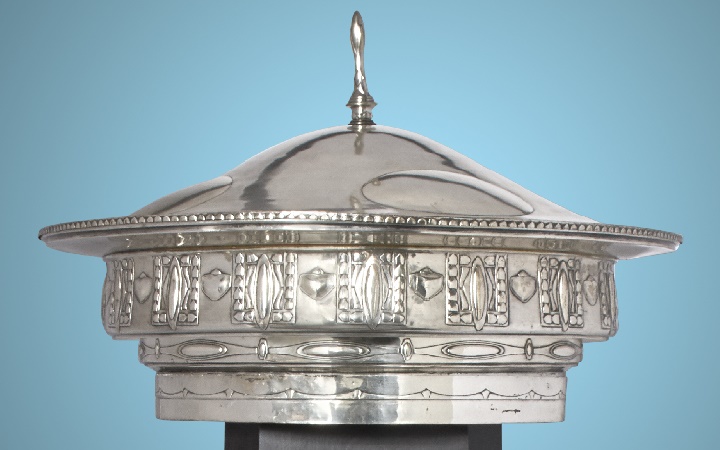Vienna Secession
05/29/2018 19th & 20th Century Furniture & Decorative Arts

NEW YORK, NY -- Austrian architect and designer Josef Maria Olbrich (1867-1908) was a founding member of the Vienna Secession movement, which was established on April 3, 1897. The other founding members included Gustav Klimt, Josef Hoffmann, Kolomon Moser, Carl Moll and Otto Wagner. In 1903, two of these pioneers, Hoffmann and Moser, established the Wiener Werkstätte.
As a young man, Olbrich studied architecture at the University of Applied Arts Vienna (Wiener Staatsgewerbeschule) and the Academy of Fine Arts Vienna. Vienna Secession Building, an exhibition hall in Vienna designed by Olbrich in 1897 and completed in 1898, is considered a landmark of the Vienna Secession movement. Simple and bold, the building is crowned with a great openwork dome. A verse in German on the building's facade reads, “Der Zeit ihre Kunst. Der Kunst ihre Freiheit,” which translates to "To every age its art. To every art its freedom." Below, a sculpture of three gorgons symbolize painting, sculpture and architecture. Inside, the building features one of the most widely recognized artworks of the Secession style, the Beethoven Frieze, painted by Gustav Klimt in 1901 in celebration of the composer. This monumental painting is 7 feet tall and 112 feet wide.
In 1904, Olbrich was honored with the highest prize awarded at the Louisiana Purchase Exposition, informally known as the St. Louis World's Fair, which was held in St. Louis, Missouri. Olbrich's entry consisted of a courtyard and decorative schemes for various rooms described in a catalogue of the Fair simply as Living Room, Tea Room, Reception Hall, Dining Room, Music Room, Library and Smoking Room. All were displayed in the German exhibition of decorative arts in the Varied Industries Building. The building consisted of forty inner rooms grouped around a central hall designed by Bruno Möhring.
A reporter for the St. Louis Post-Dispatch made the following observations of Olbrich's pavilion: "The interior decorators of the United States are now talking about the Olbrich Pavilion. It is already indicated as one of the things at the World's Fair which will leave a permanent mark upon American life."
In the introductory remarks in the publication The Descriptive Catalogue of the German Arts and Crafts at the Universal Exposition, St. Louis, 1904, published by the Imperial German Commission, Leo Nachtlicht noted:
"The German exhibit of arts and crafts in the Varied Industries building is the largest and best that Germany has ever made. Neither in Chicago 1893, Paris 1900, Turin 1902 or in Düsseldorf 1903, have the exhibitors of arts and crafts displayed such skill and excellence. The reason for the greater excellence at the Louisiana Purchase Exposition is to be found in the better organization and a keener desire to show America what is newest and best in this latest line of German effort, and in the new life that has sprung in this special line of art in the last ten years in Germany. Formerly thousands of pieces of historical furniture were decorated with the same ornaments and possessed the same style so that the entire work could be left to the mechanic, but now artist and mechanic have to work hand in hand. Heretofore the artist was rarely seen at the shop of the mechanic but now this working with the mechanic deepens his interest in the material and suggests to him the forms which are best fitted for the material used."
The passage later continues:
"The time of rich ornamentation peculiar to the rococo and baroque style have passed. Only occasionally an expression of decoration was found to be necessary as demonstrated by the capit[a]s in the [Peter] Behrens room or by the panel strips in the [Otto] Pankok [room] or by the panels on the sofa in the Olbrich room. In this careful use of ornamentation is expressed artistic restraint in which the progress of the arts and crafts can be well recognized."
Recognizing that visitors to the Varied Industries Building and the interiors on display within were excited and impressed by what they saw, the German architects and designers decided that visitors would have the opportunity to purchase the furniture and interiors on exhibition. The June 6 Doyle+Design auction features a silver plated monumental bowl and cover designed by Josef Maria Olbrich and exhibited in the Living Room display.
Josef Maria Olbrich's architectural designs in the Vienna and Darmstadt Secession style and his designs in the decorative arts -- including pottery, furniture, book bindings, musical instruments, jewelry and metalwork -- had a profound influence on the development of the Art Nouveau style.
Doyle+Design
Auction June 6, 2018
Exhibition June 2 – 4
Lot 246
Vienna Secession Silver Plated Monumental Bowl and Cover Designed by Josef Maria Olbrich for the Living Room Interior in the German Exhibit of Arts and Crafts at the Louisiana Purchase Exhibition in 1904
Height 20 inches, diameter 32 3/4 inches.
Est. $15,000-25,000